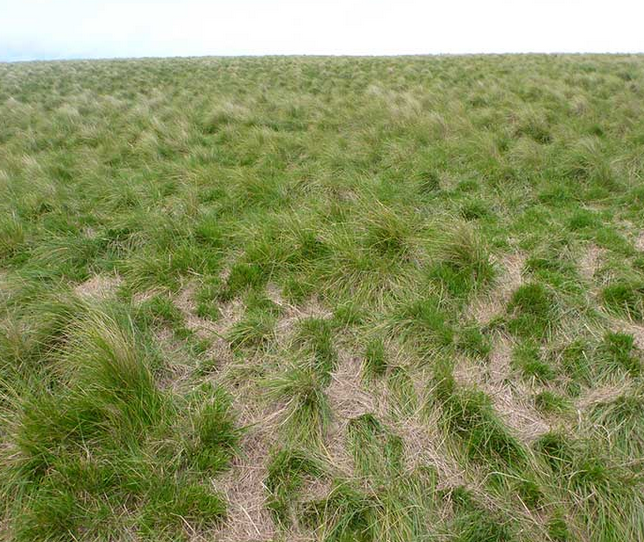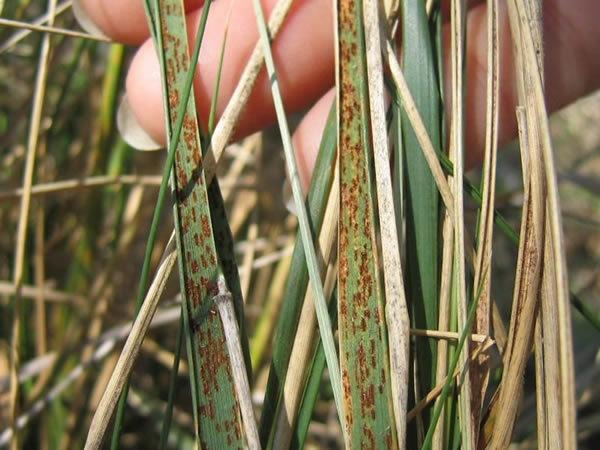Application to release the Chilean needle grass rust

Image: Chilean needle grass seed.
Difficulties have arisen in the issue of permits to allow biocontrol agents to be exported from Argentina. Manaaki Whenua - Landcare Research could not exercise the EPA approval and it expired.
Approval was again sought from EPA, based almost entirely on the information contained in the original application. Due to the same export permitting difficulties and a request for additional host range testing from a submitter, the EPA approved two time extensions until April 2024.
The original application and the EPA decision approving release of Chilean needle grass rust fungus can be found on the EPA database (2011 ERMA application), while the 2017 application can be found on EPA's website.
In September 2021 permission to export the rust fungus Uromyces pencanus was granted by the Argentinian government. The first attempt in January 2022 to successfully import living spores into containment failed due to severe transit delays. However, a second attempt was successful and in December 2022 the rust culture was hand carried from Argentina into New Zealand. New Zealand now has the only other living culture of the rust fungus in containment.
Background
This application to release a rust fungus, Uromyces pencanus as a biocontrol agent for Chilean needle grass (CNG), or Nassella neesiana is being made by Marlborough District Council, representing the National Biocontrol Collective; a consortium of regional councils, unitary authorities and the Department of Conservation. Manaaki Whenua - Landcare Research is the science advisor on the application to the Collective.
Chilean needle grass is an erect, tufted perennial grass from South America, which can grow up to one metre high in the absence of grazing. Plants form dense clumps, which exclude pasture species and are less palatable to stock, reducing farm productivity. Chilean needle grass seeds have sharp tips that can bore into the eyelids and pelts of animals, resulting in severe animal welfare issues. Managing farms to avoid Chilean needle grass damage (by destocking for the 3 month period when seeds are present for example) is a serious economic cost to affected farmers.
Chilean needle grass is more prevalent in Australia than it is in New Zealand. It reduces biodiversity in native grasslands, outcompeting indigenous species. It has been described as ‘potentially the worst environmental weed of indigenous grasslands in Victoria‛.

Image: Chilean needle grass infestation in Marlborough
Chilean needle grass is highly localised in New Zealand but is spreading, and has become worse over the past 5 years since the EPA approved the release of the rust. There are active infestations in Hawkes Bay (600 ha), Marlborough (2,800 ha) and Canterbury (220 ha). Chilean needle grass has the potential to infest 15 million hectares of New Zealand but less than 1% of this is currently invaded. The potential range includes approximately 1,000,000 hectares of high-producing pasture in Canterbury alone (Bourdôt et al. 2010).
For more information about Chilean needle grass see:

Image: rust pustules infecting Chilean needle grass leaves
Identification and assessment of risks, costs and benefits
The potential risks, costs and benefits of the proposed introduction to New Zealand of Chilean needle grass rust and the possible reduction in the abundance and vigour of Chilean needle grass were identified in 2010 by literature review (Bourdôt, 2010) and by consultation with stakeholders. The significant effects identified (highlighted in bold) were addressed in detail in the application that was approved by EPA. No further risks costs or benefits have been identified in the preparation of the new application.
It is forbidden to sell, propagate or distribute CNG. It has no significant economic or environmental value. Potential benefits of biological control would be the mitigation of the effects described above. The key possible adverse effects of introducing the agents will be addressed fully in the new application:
- the risk of direct damage to native plants
- indirect effects on flora and fauna as a result of disruption of ecological relationships
The host range of the rust is restricted to CNG in New Zealand (see below). Native and other valued plant species will not be at risk.
Because the rust will be host specific, population densities capable of interacting significantly with other plants or animals will only be found in close proximity to CNG, which has a limited distribution. As a result, no significant disturbance of ecological relationships is expected in New Zealand.
Pre-application consultation with Iwi
Before the 2010 EPA application was written, extensive consultation with Iwi, hapū, and Māori organisations was conducted through these pathways:
- 140 members of the ERMA Māori National Network (now Te Herenga) were contacted, 18 of which were papatipu rūnanga of Ngāi Tahu.
- Six Iwi or rūnanga in the Marlborough District were visited to discuss the application
- Consideration of relevant questions raised over previous applications
The findings of this consultation are summarised here:
Consultation over the current application relied on these responses, and on written announcements in 2017 to Te Herenga and Canterbury and Marlborough iwi and hapū. No additional responses were received. The application will also take account of the findings of an EPA reference group convened in 2015 to discuss the issues surrounding such applications.
Pre-application consultation with other organisations
In preparing the 2010 application, meetings were held to discuss issues with ERMANZ (now EPA) and the Department of Conservation staff. Other organisations with direct interest in CNG management were asked to raise any issues that should be addressed in the application.
Auckland Regional Council
Hawkes Bay Regional Council
Marlborough District Council
Environment Canterbury
Federated Farmers of New Zealand
ECO
NZ Plant Protection Society
Department of Conservation
New Zealand Association of Agricultural and Horticultural Science
Dr Cliff Mason
Responses received were incorporated into the 2010 application and are summarised here:
Additional information was sought from the Environment Canterbury and Marlborough District Court in 2017.
Key documents
Report on host-range determination
Safety issues are paramount to the development of biocontrol for weeds. Researchers rigorously test all proposed agents to assess the risk of damage to non-target plants. A set of procedures helps researchers choose a suitable shortlist of test plants, and this methodology is now well-accepted internationally (Wapshere, 1974). The technique is under constant review to update best practice (e.g. Sheppard et al., 2005; Briese, 2005).
Barton (2004, 2012) has reported that rust fungi can be safe and effective biocontrol agents for weeds.
The 2011 application submitted to EPA concluded that there was no significant risk to non-target species from the release of the CNG rust. This research is summarised here:
The research contained in the technical report has since been published (Anderson et al., 2010; 2011).
The EPA concurred and granted approval for release in June 2011:
When the new application to the EPA was submitted in 2017, further host range test results became available. The Australian authorities had requested testing of more Austrostipa species that are native to Australia, and quite closely related to Nassella. In those further experiments, the rust fungus was able to produce spores on two non-target species of Austrostipa: A. compressa and A. macalpinei (Anderson et al. 2017).
While neither of these Austrostipa species grow in NZ, Landcare Research decided that further testing in NZ would be advisable. Only three grasses in NZ belong in the same Stipeae tribe as Nassella and are native here: Austrostipa stipoides, Achnatherum petriei and Anemanthele lessoniana. While A. stipoides plants originating in Australia had already been included in host range tests and shown to be resistant, it was decided that plants originating in NZ should also be tested. The additional host range tests was completed in August 2023. This research is summarised here:
The introduction of Uromyces pencanus to New Zealand is unlikely to cause any significant negative impact on the three native Stipeae grasses.
Cited references
Anderson FE, Barton J, McLaren D. 2010. Studies to assess the suitability of Uromyces pencanus as a biological control agent for Nassella neesiana (Poaceae) in Australia and New Zealand. Australasian Plant Pathology 39(1).
Anderson FE, Gallego F, Sánchez RM, Flemmer AC, Hansen PV, McLaren D, Barton J 2017. Plant/pathogen interactions observed during host range testing of the rust fungus Uromyces pencanus, a classical biological control agent for Chilean needle grass (Nassella neesiana) in Australia and New Zealand. Biocontrol Science and Technology 27 (9): 1096–1117.
Barton J. 2004. How good are we at predicting the field host-range of fungal pathogens used for classical biological control of weeds? Biological Control 31: 99-122.
Barton J. 2012. Predictability of pathogen host range in classical biological control of weeds: an update. Biocontrol 57: 289-305.
Barton J, Anderson FA, McLaren DA. 2011. The biology and host range of the proposed biological control agent Uromyces pencanus. Unpublished Landcare Research Report
Bourdôt G. 2010. Chilean needle grass (Nassella neesiana) – a review of the scientific and technical literature. Unpublished report to the Chilean Needle Grass Action Group (Sustainable Farming Fund), AgResearch Client report number: SC110/2010/167. 18p.
Bourdôt GW, Lamoureaux SL, Kriticos DJ, Watt MS, Brown M 2010. Current and potential distributions of Nassella neesiana (Chilean needle grass) in Australia and New Zealand. In: New Frontiers in New Zealand, Together We Can Beat the Weeds, Proceedings of the Seventeenth Australasian Weeds Conference, Christchurch, New Zealand, 26–30 September 2010. Zydenbos SM (ed). New Zealand Plant protection Society: Christchurch, New Zealand. pp. 424–427.
Briese D. 2005. Translating host-specificity test results into the real world: The need to harmonize the yin and yang of current testing procedures. Biological Control 35: 208–214.
Sheppard AW, Heard TA, van Klinken RD. 2005. Scientific advances in the analysis of direct risks of weed biological control agents to non-target plants. Biological Control 35: 215–226.
Wapshere AJ. 1974. A strategy for evaluating the safety or organisms for biological weed control. Annals of Applied Biology 77: 201–211.
Key contact
